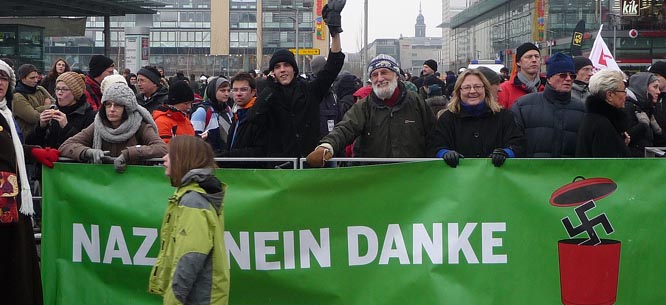Welcome to DU!
The truly grassroots left-of-center political community where regular people, not algorithms, drive the discussions and set the standards.
Join the community:
Create a free account
Support DU (and get rid of ads!):
Become a Star Member
Latest Breaking News
General Discussion
The DU Lounge
All Forums
Issue Forums
Culture Forums
Alliance Forums
Region Forums
Support Forums
Help & Search
General Discussion
Related: Editorials & Other Articles, Issue Forums, Alliance Forums, Region ForumsDresden, Nazi-Free: The New Politics of German Civil Disobedience
from Dissent magazine:
Dresden, Nazi-Free: The New Politics of German Civil Disobedience
By Moritz Wichmann - March 8, 2013

This year the anti-fascist alliance Dresden Nazifrei (Dresden Without Nazis) can look back on three years of successful campaigning against the largest annual Nazi demonstration in all of Europe. In these years, the eastern German city and capital of Saxony became the site of an intense political struggle over civil disobedience and how to adequately respond to thousands of neo-Nazis marching annually in the streets. It also became the site of an ongoing authoritarian-conservative backlash against social movements and against the national discourse about Germany’s National-Socialist past.
Turning the Tide
February 13 marks the date of the 1945 Allied bombings of Dresden. In their demonstrations on the weekend following the anniversary, Nazis would “mourn” the loss of “innocent lives” among the population of a cultural city—the “Florence at the Elbe River,” as Dresden is sometimes called. This provided them with an opportunity not only to establish a positive connection with the population of Dresden in the 1940s and affirm the National-Socialist identity of neo-Nazis (stopping the infighting in the fascist scene for a day), but also to engage in some historical revisionism and relativize the Holocaust. To wit, Juergen Gansel, representative of the neo-Nazi National Democratic Party (NPD), proclaimed in 2005 that the Allied bombing of Dresden was not only unnecessary and a war crime, but a “bombing holocaust.”
The first march in Dresden around February 13 was organized by the Junge Landsmannschaft Ostdeutschland (Youth Corps of East Germany) in 1999 and was attended by 150 local neo-Nazis. From 2008 on, local neo-Nazis organized a second, locally mobilized march on the evening of February 13. By 2009, the march had become Europe’s biggest gathering of Nazis, with delegations of far-right parties from other European countries attending the national rally on the weekend after February 13.
At its peak in 2009, up to 7,000 surviving Nazis and neo-Nazis dressed in black and gray coats filed in tight formation through the wintry streets of Dresden’s beautiful historical center, holding flags and burning torches in the half-light of the late afternoon, making their march a silent demonstration of power. Later in the evening of February 14, neo-Nazis attacked several counter-protesters while traveling home, including a forty-two-year-old union member who was brought to the hospital with a skull fracture after being kicked repeatedly. In those days, Dresden presented the world with an old, ugly Germany that some had hoped was gone forever. ..................(more)
The complete piece is at: http://www.dissentmagazine.org/online_articles/dresden-nazi-free-the-new-politics-of-german-civil-disobedience
InfoView thread info, including edit history
TrashPut this thread in your Trash Can (My DU » Trash Can)
BookmarkAdd this thread to your Bookmarks (My DU » Bookmarks)
2 replies, 1079 views
ShareGet links to this post and/or share on social media
AlertAlert this post for a rule violation
PowersThere are no powers you can use on this post
EditCannot edit other people's posts
ReplyReply to this post
EditCannot edit other people's posts
Rec (7)
ReplyReply to this post
2 replies
 = new reply since forum marked as read
Highlight:
NoneDon't highlight anything
5 newestHighlight 5 most recent replies
= new reply since forum marked as read
Highlight:
NoneDon't highlight anything
5 newestHighlight 5 most recent replies
Dresden, Nazi-Free: The New Politics of German Civil Disobedience (Original Post)
marmar
Mar 2013
OP
BAT21
(42 posts)1. Very informative.
Hell of an article, thanks for posting it.
xchrom
(108,903 posts)2. Du rec. Nt